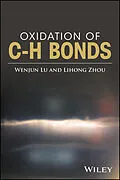A combination of oxidation methods and C H bond functionalization, this book emphasizes mechanistic understanding and critical analysis of synthetic reactions to offer a guide or manual for practicing chemists. Combines oxidation methods and C H bond functionalization, two of the most important aspects of organic synthesis Deals with C H bonds, an area of dynamic and continuous research across chemistry and catalysis Helps readers understand the fundamental and applied differences among various oxidation methods and reactions Covers mechanistic details, conditions, oxidation reagents, and practical aspects of different reactions
Autorentext
Wenjun Lu, D.Eng., is a Professor of Organic Chemistry at Shanghai Jiao Tong University.
Lihong Zhou, PhD, is a Research Associate at Shanghai Jiao Tong University.
Klappentext
Oxidation reactions are extremely important and belong to the most employed reactions in the chemical industry. Many reaction pathways (mechanisms), different reaction conditions, and corresponding oxidation reagents have been realized and established to make the oxidation of CH bonds more efficient and practical in organic synthesis.
Oxidation of CH Bonds combines oxidation methods and CH bond functionalization, two of the most important aspects of organic synthesis, in a unique guide for practicing chemists. Coverage includes early reactions, development, and updated examples of the functionalization of various CH bonds. Since many fundamental concepts about reactions, mechanisms, and synthesis strategies will be explained and discussed in the text, it is also very beneficial to chemistry students and those in need of a primer.
Featuring the perspectives and expertise of practicing chemical researchers, this book provides a valuable reference and resource for the organic chemistry community. Key benefits include:
- Offers a guide or manual to solve challenges of chemical transformation
- Deals with CH bonds, an area of dynamic and continuous research across chemistry and catalysis
- Helps readers understand the fundamental and applied differences among various oxidation methods and reactions
- Emphasizes mechanistic understanding of reactions and critical analysis of them
Zusammenfassung
A combination of oxidation methods and CH bond functionalization, this book emphasizes mechanistic understanding and critical analysis of synthetic reactions to offer a guide or manual for practicing chemists.
• Combines oxidation methods and CH bond functionalization, two of the most important aspects of organic synthesis
• Deals with CH bonds, an area of dynamic and continuous research across chemistry and catalysis
• Helps readers understand the fundamental and applied differences among various oxidation methods and reactions
• Covers mechanistic details, conditions, oxidation reagents, and practical aspects of different reactions
Inhalt
Preface xi
1 Introduction 1
1.1 What Is Oxidation of CH Bonds? 1
1.2 Chemical Synthesis and Oxidation of CH Bonds 2
1.3 CH Bonds 6
1.4 Concepts in This Book 15
References 17
2 Oxidation of Methane 19
2.1 Methane 19
2.2 Methyl sp³ CH Bond 20
2.3 Oxidations of Methyl sp³ CH Bond 21
2.4 Summary 35
References 36
3 Oxidation of Alkyl sp³ CH Bond 39
3.1 Alkane 39
3.2 Alkyl sp³ CH Bonds 40
3.3 Oxidations of Alkyl sp³ CH Bond 42
3.4 Summary 61
References 62
4 Oxidation of Alkyl sp³ CH Bond Assisted by Directing Group 65
4.1 Directing Group 65
4.2 Alkyl sp³ CH Bonds with Directing Groups 66
4.3 Directed Oxidations of Alkyl sp³ CH Bond 67
4.4 Summary 97
References 97
5 Oxidation of Alkyl sp³ CH Bond Adjacent to Unsaturated Carbon Atom 101
5.1 Alkyl ?-sp³ CH Bond 101
5.2 Alkyl sp³ CH Bonds Adjacent to Unsaturated Carbon Atoms 102
5.3 Oxidations of Alkyl sp³ CH Bond Adjacent to Unsaturated Carbon Atom 103
5.4 Summary 138
References 138
6 Oxidation of Alkyl sp³ CH Bond Adjacent to Heteroatom 143
6.1 Alkyl sp³ CH Bonds Adjacent to Heteroatoms 143
6.2 Oxidations of Alkyl sp³ CH Bond Adjacent to Heteroatom 144
6.3 Summary 166
References 167
7 Oxidation of Alkenyl or Carbonyl sp² CH Bond 171
7.1 Alkenyl and Carbonyl sp² CH Bonds 171
7.2 Oxidations of Alkenyl and Carbonyl sp² CH Bonds 172
8 Oxidation of Alkynyl spCH Bond 209
8.1 spCH Bonds 209
8.2 Oxidations of spCH Bond 210
8.3 Summary 232
References 232
9 Oxidation of Benzene 235
9.1 Introduction 235
9.2 Oxidations of Phenyl sp2 CH Bond 237
9.3 Summary 277
References 279
10 Oxidation of Aryl sp² CH Bond on Substituted Benzene 283
10.1 Introduction 283
10.2 Formation of CC Bond 284
10.3 Formation of CN Bond 313
10.4 Formation of CO Bond 316
10.5 Formation of CS Bond 322
10.6 Formation of CHalogen Bond 323
10.7 Summary 331
References 333
11 Oxidation of Aryl sp² CH Bond Assisted by Directing Group 337
11.1 Introduction 337
11.2 Formation of CC Bond 337
11.3 Formation of CN Bond 400
11.4 Formation of CO Bond 406
11.5 Formation of CS Bond 412
11.6 Formation of CHalogen Bond 414
11.7 Summary 424
References 426
12 Oxidation of Aryl sp² CH Bond on Heteroarene or Perfluoroarene 433
12.1 Introduction 433
12.2 Formation of CC Bond 434
12.3 Formation of CN Bond 459
12.4 Formation of CO Bond 461
12.5 Formation of CHalogen Bond 462
12.6 Cross?-Coupling of Dual Aryl sp² CH Bonds on Directing?-Group?-Containing Arenes, Heteroarenes, or
Polyfluoroarenes 468
12.7 Summary 477
References 478
13 Oxidative Cross?-Coupling of Aryl sp² CH Bond with Inert CH Bond 483
13.1 Introduction 483
13.2 Oxidative Coupling of Simple Arenes with Alkanes (Alkylation of Arenes) 484
13.3 Oxidative Coupling of Simple Arenes with Alkenes (Alkenylation of Arenes) 486
13.4 Oxidative Cross?-Coupling of Simple Arenes (Arylation of Arenes) 490
13.5 Summary 498
